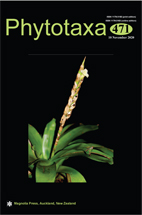Abstract
Three Panamanian cloud forest species in the genus Lycianthes are newly described: L. coloradensis, from the Ngäbe-Buglé Comarca; L. fortunensis from Chiriquí Province, Veraguas Province, and the Ngäbe-Buglé Comarca; and L. talamancensis from Bocas del Toro and Chiriquí provinces. All three species are woody vines with tan, yellow, or orange-brown multangulate-stellate trichomes and entire to nearly entire white to purple corollas. In terms of vegetative morphology and trichome characteristics, L. coloradensis most closely resembles L. purpusii of Mexico, Guatemala, and Honduras, L. fortunensis resembles the widespread L. multiflora, and L. talamancensis resembles L. hortulana of Honduras, El Salvador, and Nicaragua. This article provides species descriptions, maps of geographic distributions, specimen images of each species, and comparison tables of morphological characters used to separate L. coloradensis, L. fortunensis and L. talamancensis from similar species.
References
Bohs, L. (1994) Cyphomandra (Solanaceae). Flora Neotropica Monograph 63: 1–175.
Brandegee, T. (1914) Plantae Mexicanae Purpusianae VI. University of California Publications in Botany 6: 55–77.
Child, A. & Lester, R. (1991) Life form and branching within the Solanaceae. In: Hawkes, J.G., Lester, R.N., Nee, M. & Estrada-R., N. (Eds.) Solanaceae III, taxonomy, chemistry, evolution. The Royal Botanic Gardens, Kew, Richmond, Surrey, U. K., pp. 151–159.
Cronquist, A. (1978) Once again, what is a species? In: Romberger, J.A. (Ed.) Biosystematics in agriculture. Allanheld and Osmun, Montclair, New Jersey, pp. 3–20.
D’Arcy, W.G. (1986) The calyx in Lycianthes and some other genera. Annals of the Missouri Botanical Garden 73: 117–127.
<a href="https://doi.org/10.2307/2399143">https://doi.org/10.2307/2399143</a>
D’Arcy, W.G. (1973) [1974] Solanaceae. In: Woodson, R.E. & Schery, R.W. Jr. (Eds.) Flora of Panama, 60. Annals of Missouri Botanical Garden, pp. 573–780.
<a href="https://doi.org/10.2307/2395139">https://doi.org/10.2307/2395139</a>
D’Arcy, W.G. (1991) The Solanaceae since 1976, with a review of its biogeography. In: Hawkes, J.G., Lester, R.N., Nee, M. & Estrada-R., N. (Eds.) Solanaceae III: taxonomy, chemistry, evolution. The Royal Botanic Gardens, Kew, Richmond, Surrey, U. K., pp. 75–137.
Dean, E. (2001) The post-anthesis floral biology of Lycianthes series Meizonodontae (Solanaceae): variation in filament elongation, anther dehiscence, floral movement, and corolla growth. In: van den Berg, R., Barendse, G., van der Weerden, G. & Maríani, C. (Eds.) Solanaceae V, advances in taxonomy and utilization. Nijmegen University Press, Nijmegen, Netherlands, pp. 137–151.
Dean, E. (2004) A taxonomic revision of Lycianthes series Meizonodontae (Solanaceae). Botanical Journal of the Linnean Society 145: 385–424.
<a href="https://doi.org/10.1111/j.1095-8339.2004.00296.x">https://doi.org/10.1111/j.1095-8339.2004.00296.x</a>
Dean, E., Reyes, M., Fauré, R., Walden, G., Brandon, D., Canington, D. & McNair, D. (2017) Identification of the species of Lycianthes series Tricolores (Capsiceae, Solanaceae). Systematic Botany 42: 191–209.
<a href="https://doi.org/10.1600/036364417X694566">https://doi.org/10.1600/036364417X694566</a>
Dean, E., Archila, F., Poore, J. Kang, H., Anguiano-Constante, M.A., Starbuck, T. & Rodriquez, A. (2019) Two new species of Lycianthes (Capsiceae, Solanaceae) from Mexico and Guatemala. Phytotaxa 409 (5): 261–272.
<a href="https://doi.org/10.11646/phytotaxa.409.5.2">https://doi.org/10.11646/phytotaxa.409.5.2</a>
Dunal, M.F. (1852) Solanaceae. In: De Candolle, A.P. (Ed.) Prodromus Systematis Naturalis Regni Vegetabilis 13 (1). V. Masson, Paris, France, pp. 1–690.
Gunn, C. & Gaffney, F. (1974) Seed Characteristics of 42 Economically Important Species of Solanaceae in the United States. United States Department of Agriculture Technical Bulletin No. 1471. U.S. Government Printing Office, Washington, D. C.
Guzmán, F.A., Dean, E. & Bohs, L. (2009) Hot or not so hot: phylogenetic relationships in Capsicum and Lycianthes (Solanaceae). In Poster presented at the Botany and Mycology 2009 Meeting, Snowbird, Utah. [<a href="http://2009.botanyconference.org/engine/search/index.php">http://2009.botanyconference.org/engine/search/index.php</a>]
Harrington, H. & Durrell, L. (1974) How to identify plants. Swallow Press, Athens, Ohio.
Hassler, E. (1917) Solanaceae Austro-Americanae Imprimis Paraguariensis. Annuaire du Conservatoire et du Jardin Botaniques de Genève 20: 173–183.
Hunziker, A.T. (2001) Genera Solanacearum: The genera of Solanaceae illustrated, arranged according to a new system. A. R. G. Gantner, Ruggell, Liechtenstein, 500 pp.
Linnaeus, C. (1753) Species Plantarum, Tomus I. Impensis Laurentii Salvii, Holmiae [Stockholm], 1200 pp.
Radford, A., Dickison, W., Massey, J. & Bell, C. (1974) Vascular Plant Systematics. Harper and Row Publishers, New York, New York.
Rios, N.E. & Bart, H.L. (2010) GEOLocate (Version 3.22) [Computer software]. Belle Chasse, Louisiana: Tulane University Museum of Natural History.
Roe, K. (1968) A revision of Solanum sect. Brevantherum (Solanaceae) in North and Central America. Brittonia 19: 353–373.
<a href="https://doi.org/10.2307/2805534">https://doi.org/10.2307/2805534</a>
Roe, K. (1971) Terminology of hairs in the genus Solanum. Taxon 20: 501–508.
<a href="https://doi.org/10.2307/1218251">https://doi.org/10.2307/1218251</a>
Särkinen, T., Bohs, L., Olmsted, R. & Knapp, S. (2013) A phylogenetic framework for evolutionary study of the nightshades (Solanaceae): a dated 1000-tip tree. BMC Evolutionary Biology 13: 214.
<a href="https://doi.org/10.1186/1471-2148-13-214">https://doi.org/10.1186/1471-2148-13-214</a>
Standley, P.C. & Williams, L.O. (1952) Plantae Centrali-Americanae III. Ceiba 3: 35–66.
Sullivan, D. (2009) Google Earth Pro. EContent 32: 16–18.
Thiers, B. (continuously updated) Index herbariorum, a global directory of public herbaria and associated staff. New York Botanical Garden’s Virtual Herbarium. Available from: <a href="http://sweetgum.nybg.org/ih/">http://sweetgum.nybg.org/ih/</a> (accessed 22 March 2019)

